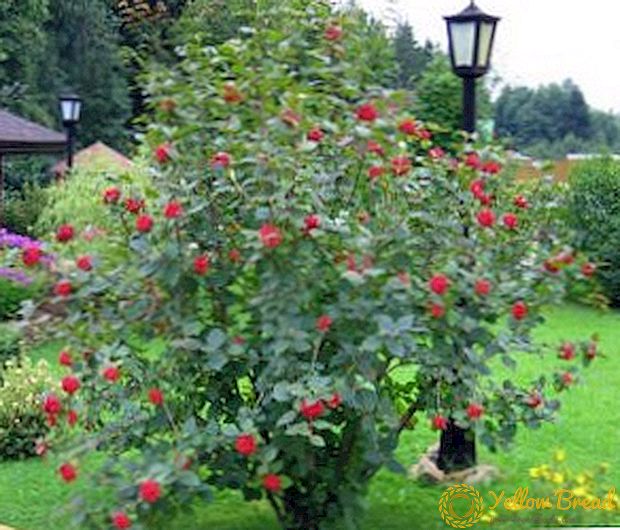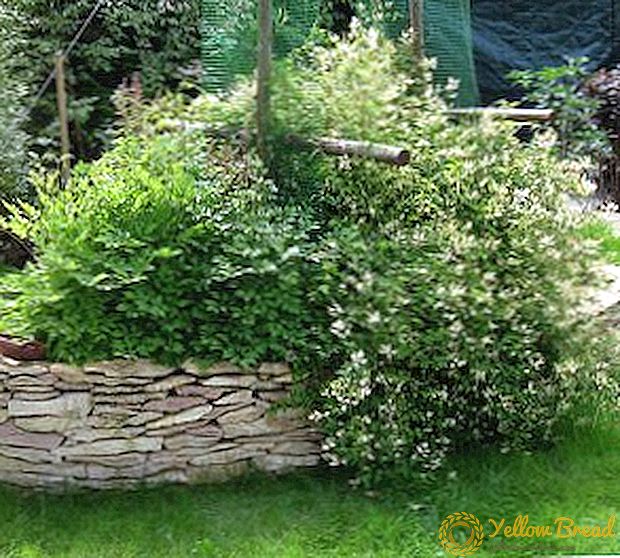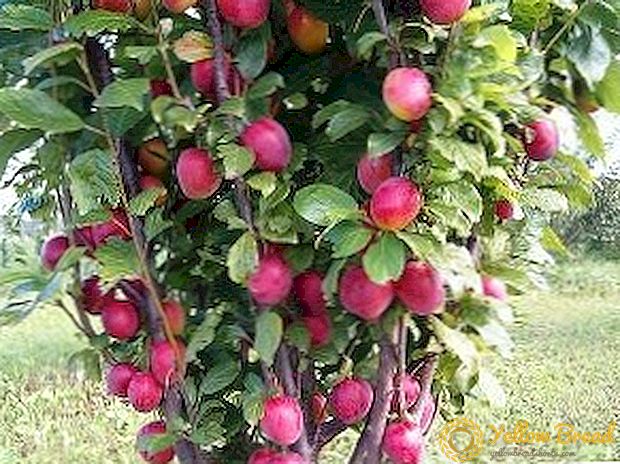 It is probably very difficult to imagine a summer cottage without any bush with tasty healthy berries On him. But still many gardeners are wondering about which berry bushes are most suitable for their garden or dacha, in this article we will get acquainted with the names of such plants and the rules of caring for them.
It is probably very difficult to imagine a summer cottage without any bush with tasty healthy berries On him. But still many gardeners are wondering about which berry bushes are most suitable for their garden or dacha, in this article we will get acquainted with the names of such plants and the rules of caring for them.
- Honeysuckle
- Description
- Care rules
- Blueberries
- Description
- Care rules
- Currant
- Description
- Care rules
- Gooseberry
- Description
- Care rules
- Blackberry
- Description
- Care rules
- Lingonberry
- Description
- Care rules
- Cranberry
- Description
- Care rules
Honeysuckle

Honeysuckle is a shrub, which in our country began to grow relatively recently. There are only two cultivated species. These include garden honeysuckle (also known as edible) and blue honeysuckle. Of course, you can meet others, but they are all derived on the basis of only these two types.
Description
Honeysuckle edible - It is a spherical shrub whose height reaches one and a half meters. Thin young shoots are purple color. Old branches, up to 30 mm thick, have a bark with a dark yellow shade, the leaves in length reach 70 mm.It blooms, as a rule, at the end of May with light yellow flowers. The length of the fruit of the honeysuckle garden varies from 10 mm to 13 mm. The peel on the berries has a blue color with a light bluish bloom, and the flesh is bright red.
Blue honeysuckle - in height it can reach 2.5 m, it has straight shoots with a slight bend. The bark of this plant is brown with a reddish or grayish tinge. Leaf length up to 60 mm. The berries are oblong. In all other respects, it is very similar to garden honeysuckle. 
Care rules
Pruning young berry bushes is carried out, three years after planting, but the adult plant does not need any serious pruning. You should only remove dry or damaged twigs and shoots that grow from the ground.
Honeysuckle needs moderate watering, it should be watered abundantly in spring and early summer, but only if it is dry to avoid the bitterness of the berries. If it rains periodically throughout the season, then you will have to water the honeysuckle only 3 or 4 times. After each watering or rain, it is necessary to flood the soil to a depth of no more than 8 cm.
Blueberries

Bilberry is a very low dense shrub that easily tolerates winter frosts.In its natural environment, it can be found in a mixed or coniferous forest, because, like conifers, it prefers a sour soil. Blueberries love shade, so they should be planted under trees or in other shading places.
Description
Bilberry is a perennial low-growing plant of the heather family, the height of the bush does not exceed 35 cm. The root is long, but spreads in breadth. The leaves are smooth, up to 30 mm long, green in color, slightly covered with hairs. Flowering begins in May, whitish-pink flowers. Blueberries are very similar to the fruits of honeysuckle, differing only in spherical shape and size. 
Care rules
Regular pruning of blueberries is started at the 3rd year of life, as always, dry and damaged branches are cut off. Many sources indicate that the bush should have about 8 branches, which are the basis of the bush. If a large number of lateral shoots appear on bilberries, they should be removed completely, since the berries on such branches are very small and ripen for a long time. Shrubs that are more than 10 years old, need to be cut to 20 cm from the ground, this procedure rejuvenates the plant and increases the yield.
Blueberries need frequent, but moderate watering. Excessive moisture causes the roots to rot.
Currant

Currant is one of the most common berry crops in our country. It is used both in its raw form, and it is made from jam, compote, wine and various liqueurs. It is also widely used in medicine for medicinal and vitamin preparations.
Description
Currant is perennial family Kryzhovnikovs, whose height reaches two meters. Young shoots are light green in color, over time they darken and become brown. Currant has a deep root system, which go underground for more than half a meter. Leaf diameter varies from 4 cm to 12 cm. Currant begins to bear fruit two years after planting. It blooms with pale yellow flowers. The berries ripen in July and August, and depending on the variety have a different color and size. 
Care rules
For the currant is most suitable sunny place, the soil should not be acidic, well-drained.
After winter, you should carefully examine all branches of the plant, damaged kidneys should be removed, if most of the buds on the branch are affected by diseases, then the entire branch should be removed.
As for irrigation, on the condition of a snowy winter, in spring the irrigation is carried out infrequently, since the ground will be very wet after the snow melts. If it was not, then the currants should be watered as the soil dries. In the summer, especially during the formation of berries, watering currants should be every 5-6 days at the rate of 2 buckets per plant. Water should be poured only under a bush, experienced gardeners advise to dig around a bush a groove about 10 cm deep and 80 cm in diameter. After each watering, the soil is loosened. Also, between watering, it is recommended to feed the bushes with a small amount of organic fertilizer. If the autumn was dry, then it is necessary to water before wintering so that the moisture is enough until the end of the cold weather.
Gooseberry

Under favorable conditions, the gooseberry can live for more than two decades, but there have been cases that it grew 40 years or more, while giving a rich harvest.
Description
Gooseberry - It is a perennial self-pollinating shrub whose height reaches one and a half meters. The trunk is covered with brownish bark with prickles. Gooseberry leaves are pale green to 60 mm in length. It blooms most often in May, the flowers are red or green. The berries are very rich in vitamins and nutrients, have an oval shape, covered with bristles, and their length is 1.5 cm, but there are bred varieties in which the length of the berries reaches 4 cm. 
Care rules
With the onset of the first spring heat, gooseberries should be subjected to heat treatment with boiling water using a spray gun. This procedure is necessary in order to prevent infection by diseases and the appearance of parasites.
In early May, it is necessary to loosen the soil around the bush, it is recommended to dig a groove of about 80-90 cm.
Gooseberries are very demanding for watering, special attention should be paid during the flowering and ripening of fruits.The irrigation procedure is similar to currant irrigation.
Pruning is carried out in the autumn, because during spring pruning the plant can be badly damaged.
Blackberry

Blackberry is a forest berry shrub, its berries resemble a mixture of raspberries and mulberries. It would be more usual to meet him in the forest, but not so long ago the blackberry was domesticated, many varieties adapted to certain climatic conditions have already been developed.
Description
Blackberry is a perennial shrub belonging to the Rosaceae family. Under certain conditions it can reach a height of up to two meters. Its straight, long branches have a gray with a brownish tinge, the bark covered with sharp thorns, but you can find hybrids without them.

Care rules
Only planted blackberries need to be watered as often as possible for 45 days.Old bushes also need frequent watering, especially during the drought period. Mostly suitable for irrigation is separated rain water. It is better to drain the water into a barrel or another vessel, let stand for several days.
Pruning is done every fall or spring. First of all, dry and drying sprigs are cut, and then the branches that are already bearing fruit are subject to obligatory pruning.
Lingonberry

Lingonberry is an evergreen shrub, the berries and leaves of which are appreciated by most people for the huge amount of vitamins and useful elements they contain. It is well established in traditional medicine due to its beneficial properties. Lingonberry is widespread in wild forests, forest plantations near the fields, parks and in the suburban areas.
Description
Lingonberry belongs to the Cowberry family. In height, such a shrub reaches only half a meter. The leaves of this shrub are dark green and very dense. Flowering begins in late May or early June with pink flowers. Its berries do not exceed 1 cm in diameter, grow in clusters, ripen at the end of summer and endowed with a bright, red color. 
Care rules
Lingonberry pruning, as a rule, is carried out only for decorative purposes in order to thin out the bush, as it grows very densely. Mineral and organic fertilizers can be applied at any time from the moment of flowering to harvest. Lingonberry moisture-loving plant therefore needs frequent watering. During a drought, gardeners are advised to create a rain effect. Very important for this plant is frequent loosening and removal of weeds, it is useful to make mulching.
Cranberry

Cranberries are considered to be unique berries, as they have not only original taste, but also unique healing properties. In addition, the plant can be used to decorate the backyard territory - snowy flowers and bright berries will be the decoration of any cottage.
Description
Cranberries belong to the evergreen shrubs of the Lingonberry family. The shoots of this marsh plant stretch almost a meter, forming a thick carpet of leaves and thin branches. The leaves themselves, as a rule, are small and do not exceed two cm in length, and one cm in width.The color of the foliage is predominantly dark green with a bluish tint due to the wax on the underside. Cranberry flowers are arranged in pairs on long stalks, seemingly drooping and with four lobes bent upwards. The color range ranges from pink to red. Shrub in late spring or early summer. And by August-September bright red large berries, which persist throughout the winter, completely ripen on the plant. 
Care rules
When planting the plant should be watered well. For early rooting watering is better to exercise every day however, do not pour cranberries. In summer, it is advisable to fertilize the shrub with superphosphate or other fertilizers containing minerals, but in small quantities. Every three years, the ground under the cranberries must be mulched with sand or peat to maintain a favorable microclimate of the plant.
It is important to weed weeds around the cranberries in the early stages of its life, in the future the shoots of the bush themselves will create a dense layer that will not allow the weeds to germinate.
In this article, we met with the most popular among the gardeners of berry bushes, which are ideal for growing in summer cottages in the climate of our country.






